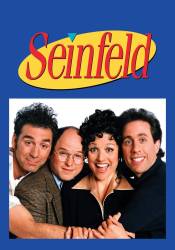Continuity mistake: When Kramer is talking with Elaine and her coworker in the publishing office, his cigar appears and disappears between shots, as well as switches from his hand to his mouth in others, and from lit to not lit in others. (00:01:05)

Continuity mistake: When George is with his girlfriend at the coffee shop, the ketchup bottle on the table switches between being knocked over and stood up in different shots, despite nobody ever touching it. (00:03:10)
Continuity mistake: When Jerry opens the magazine to the article about him before handing it to George, the left side is mostly black with a picture and the right side is half black with "now" in big yellow letters. In the next shot of him handing the magazine to George, the page seen is mostly white with fine print and a small picture. In the next shots of George reading it, the magazine is back to where Jerry had opened it up to the first time.






Answer: Composer Jonathan Wolff used a synthesizer, although in seasons 7-9, a real bass is used in addition. Wolff also recorded himself making hundreds of mouth noises, pops, and slaps to add to the synthesized bass licks so that each episode has a different theme. The only real "back-story" is Jerry Seinfeld was having trouble coming up with a theme song and talked to a friend who happened to know Wolff. They wanted to avoid that cheesy late 80's sit-com theme song and Wolff came up with what we enjoy now. Jonathan Wolff has also talked about this further in interviews, recently Reed Dunela interviewed him, so for a fuller account of his story; check out "The Wolff of 116th street".
Bishop73